Capital One 2011 Annual Report Download - page 230
Download and view the complete annual report
Please find page 230 of the 2011 Capital One annual report below. You can navigate through the pages in the report by either clicking on the pages listed below, or by using the keyword search tool below to find specific information within the annual report.-
 1
1 -
 2
2 -
 3
3 -
 4
4 -
 5
5 -
 6
6 -
 7
7 -
 8
8 -
 9
9 -
 10
10 -
 11
11 -
 12
12 -
 13
13 -
 14
14 -
 15
15 -
 16
16 -
 17
17 -
 18
18 -
 19
19 -
 20
20 -
 21
21 -
 22
22 -
 23
23 -
 24
24 -
 25
25 -
 26
26 -
 27
27 -
 28
28 -
 29
29 -
 30
30 -
 31
31 -
 32
32 -
 33
33 -
 34
34 -
 35
35 -
 36
36 -
 37
37 -
 38
38 -
 39
39 -
 40
40 -
 41
41 -
 42
42 -
 43
43 -
 44
44 -
 45
45 -
 46
46 -
 47
47 -
 48
48 -
 49
49 -
 50
50 -
 51
51 -
 52
52 -
 53
53 -
 54
54 -
 55
55 -
 56
56 -
 57
57 -
 58
58 -
 59
59 -
 60
60 -
 61
61 -
 62
62 -
 63
63 -
 64
64 -
 65
65 -
 66
66 -
 67
67 -
 68
68 -
 69
69 -
 70
70 -
 71
71 -
 72
72 -
 73
73 -
 74
74 -
 75
75 -
 76
76 -
 77
77 -
 78
78 -
 79
79 -
 80
80 -
 81
81 -
 82
82 -
 83
83 -
 84
84 -
 85
85 -
 86
86 -
 87
87 -
 88
88 -
 89
89 -
 90
90 -
 91
91 -
 92
92 -
 93
93 -
 94
94 -
 95
95 -
 96
96 -
 97
97 -
 98
98 -
 99
99 -
 100
100 -
 101
101 -
 102
102 -
 103
103 -
 104
104 -
 105
105 -
 106
106 -
 107
107 -
 108
108 -
 109
109 -
 110
110 -
 111
111 -
 112
112 -
 113
113 -
 114
114 -
 115
115 -
 116
116 -
 117
117 -
 118
118 -
 119
119 -
 120
120 -
 121
121 -
 122
122 -
 123
123 -
 124
124 -
 125
125 -
 126
126 -
 127
127 -
 128
128 -
 129
129 -
 130
130 -
 131
131 -
 132
132 -
 133
133 -
 134
134 -
 135
135 -
 136
136 -
 137
137 -
 138
138 -
 139
139 -
 140
140 -
 141
141 -
 142
142 -
 143
143 -
 144
144 -
 145
145 -
 146
146 -
 147
147 -
 148
148 -
 149
149 -
 150
150 -
 151
151 -
 152
152 -
 153
153 -
 154
154 -
 155
155 -
 156
156 -
 157
157 -
 158
158 -
 159
159 -
 160
160 -
 161
161 -
 162
162 -
 163
163 -
 164
164 -
 165
165 -
 166
166 -
 167
167 -
 168
168 -
 169
169 -
 170
170 -
 171
171 -
 172
172 -
 173
173 -
 174
174 -
 175
175 -
 176
176 -
 177
177 -
 178
178 -
 179
179 -
 180
180 -
 181
181 -
 182
182 -
 183
183 -
 184
184 -
 185
185 -
 186
186 -
 187
187 -
 188
188 -
 189
189 -
 190
190 -
 191
191 -
 192
192 -
 193
193 -
 194
194 -
 195
195 -
 196
196 -
 197
197 -
 198
198 -
 199
199 -
 200
200 -
 201
201 -
 202
202 -
 203
203 -
 204
204 -
 205
205 -
 206
206 -
 207
207 -
 208
208 -
 209
209 -
 210
210 -
 211
211 -
 212
212 -
 213
213 -
 214
214 -
 215
215 -
 216
216 -
 217
217 -
 218
218 -
 219
219 -
 220
220 -
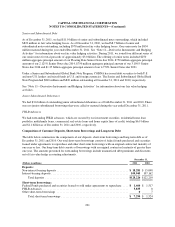 221
221 -
 222
222 -
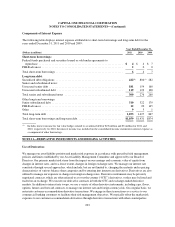 223
223 -
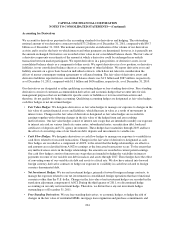 224
224 -
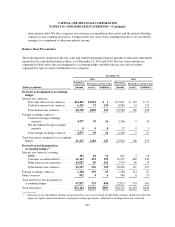 225
225 -
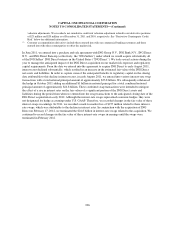 226
226 -
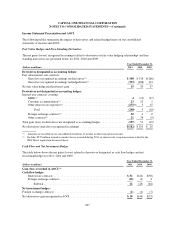 227
227 -
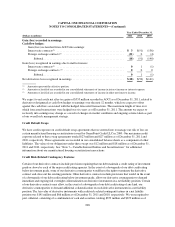 228
228 -
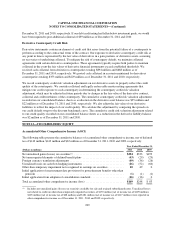 229
229 -
 230
230 -
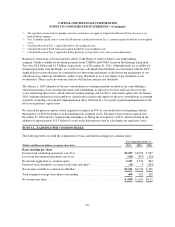 231
231 -
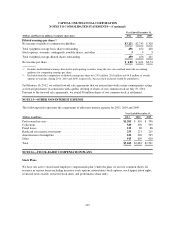 232
232 -
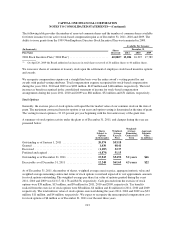 233
233 -
 234
234 -
 235
235 -
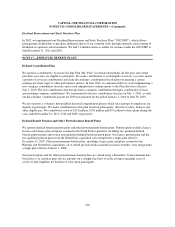 236
236 -
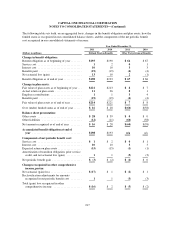 237
237 -
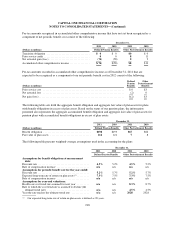 238
238 -
 239
239 -
 240
240 -
 241
241 -
 242
242 -
 243
243 -
 244
244 -
 245
245 -
 246
246 -
 247
247 -
 248
248 -
 249
249 -
 250
250 -
 251
251 -
 252
252 -
 253
253 -
 254
254 -
 255
255 -
 256
256 -
 257
257 -
 258
258 -
 259
259 -
 260
260 -
 261
261 -
 262
262 -
 263
263 -
 264
264 -
 265
265 -
 266
266 -
 267
267 -
 268
268 -
 269
269 -
 270
270 -
 271
271 -
 272
272 -
 273
273 -
 274
274 -
 275
275 -
 276
276 -
 277
277 -
 278
278 -
 279
279 -
 280
280 -
 281
281 -
 282
282 -
 283
283 -
 284
284 -
 285
285 -
 286
286 -
 287
287 -
 288
288 -
 289
289 -
 290
290 -
 291
291 -
 292
292 -
 293
293 -
 294
294 -
 295
295 -
 296
296 -
 297
297 -
 298
298
 |
 |

CAPITAL ONE FINANCIAL CORPORATION
NOTES TO CONSOLIDATED STATEMENTS—(Continued)
NOTE 13—REGULATORY AND CAPITAL ADEQUACY
Regulation and Capital Adequacy
Bank holding companies and national banks are subject to capital adequacy standards adopted by the Federal
Reserve and the OCC, respectively. The capital adequacy standards set forth minimum risk-based and leverage
capital requirements that are based on quantitative and qualitative measures of their assets and off-balance sheet
items. Under the capital adequacy standards, bank holding companies and banks currently are required to
maintain a total risk-based capital ratio of at least 8%, a Tier 1 risk-based capital ratio of at least 4%, and a Tier 1
leverage capital ratio of at least 4% (3% for banks that meet certain specified criteria, including excellent asset
quality, high liquidity, low interest rate exposure and the highest regulatory rating) in order to be considered
adequately capitalized.
National banks are also subject to prompt corrective action capital regulations. Under prompt corrective action
capital regulations, a bank is considered to be well capitalized if it maintains a total risk-based capital ratio of at
least 10% (200 basis points higher than the above minimum capital standard), a Tier 1 risk-based capital ratio of
at least 6%, a Tier 1 leverage capital ratio of at least 5% and not be subject to any supervisory agreement, order,
or directive to meet and maintain a specific capital level for any capital reserve. A bank is considered to be
adequately capitalized if it meets the above minimum capital ratios and does not otherwise meet the well
capitalized definition. Currently, prompt corrective action capital requirements do not apply to bank holding
companies. We are also subject to minimum cash reserve requirements by the Federal Reserve totaling
approximately $1.2 billion as of December 31, 2011.
The table below provides a comparison of our capital ratios as of December 31, 2011 and 2010. As of
December 31, 2011, we exceeded minimum capital requirements and would meet the “well-capitalized” ratio
levels specified under prompt corrective action for total risk-based capital and Tier 1 risk-based capital under
Federal Reserve capital standards for bank holding companies. As of December 31, 2011, the Banks also
exceeded minimum regulatory requirements under the OCC’s applicable capital adequacy guidelines and were
“well-capitalized” under prompt corrective action requirements.
December 31,
2011(1) 2010(1)
(Dollars in millions)
Capital
Ratio
Minimum
Capital
Adequacy
Well
Capitalized
Capital
Ratio
Minimum
Capital
Adequacy
Well
Capitalized
Capital One Financial Corp:(2)
Tier 1 common equity(3) .................. 9.7% N/A N/A 8.8% N/A N/A
Tier 1 risk-based capital(4) ................ 12.0 4.0% 6.0% 11.6 4.0% 6.0%
Total risk-based capital(5) ................. 14.9 8.0 10.0 16.8 8.0 10.0
Tier 1 leverage(6) ........................ 10.1 4.0 N/A 8.1 4.0 N/A
Capital One Bank (USA) N.A.
Tier 1 risk-based capital .................. 11.2% 4.0% 6.0% 13.5% 4.0% 6.0%
Total risk-based capital ................... 15.0 8.0 10.0 23.6 8.0 10.0
Tier 1 leverage .......................... 10.2 4.0 5.0 8.3 4.0 5.0
Capital One, N.A.
Tier 1 risk-based capital .................. 11.0% 4.0% 6.0% 11.1% 4.0% 6.0%
Total risk-based capital ................... 12.2 8.0 10.0 12.4 8.0 10.0
Tier 1 leverage .......................... 8.7 4.0 5.0 8.1 4.0 5.0
(1) Calculated under capital standards and regulations based on the international capital framework commonly known as
Basel I.
210
